UV Basics


UV wavelengths from 200nm to 300nm are absorbed by the genetic material of pathogenic microorganisms, resulting in structural damage and death of the microorganisms. The most effective wavelengths are in the range of 250nm to 270nm.
Since UV light is not a chemical additive, it does not produce or leave any toxic compounds in water or wastewater, as chlorine does. In the case of chlorine disinfection, residuals are harmful to the environment, so government restrictions have led to users adding other chemicals which do not completely eliminate the hazards of chlorine. In contrast, the UV disinfection system process is an environmentally friendly, safe, sensible and cost effective solution that harnesses natural process light to disinfect water, without even affecting the aesthetic quality of drinking water.
A UV dose of less than 10,000μW seconds/cm3 kills most microorganisms. To ensure quality control is maintained in a variety of applications and water conditions, UV manufacturers specify an end-of-lamp dose (EOL) greater than this amount.
Advanced UV sets the standard in dosage precision and efficiency. With years of collecting performance data on hundreds of lamps and ballasts in various operating conditions, we have used this knowledge to design our own matched ballasts and lamp sets, which deliver performance levels higher than competitive units. Knowing actual lamp intensity in water applications allows for more efficient designs for each application.
